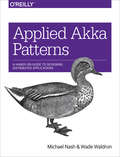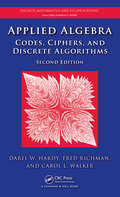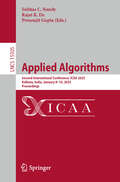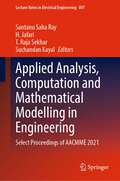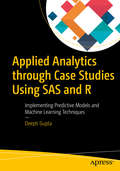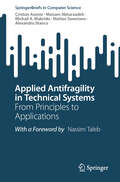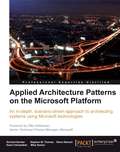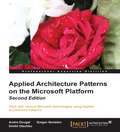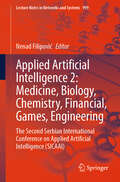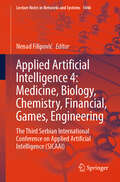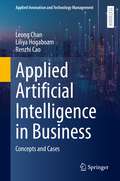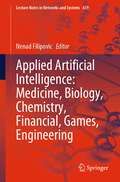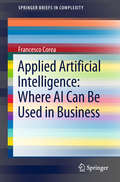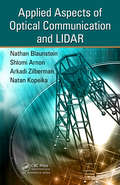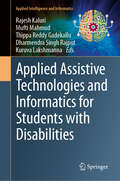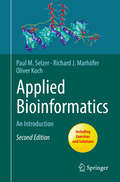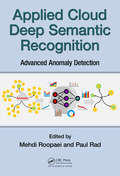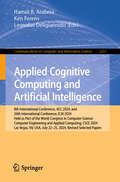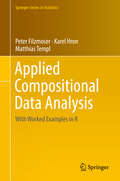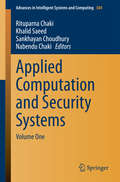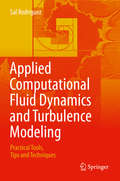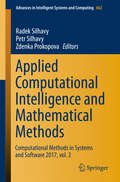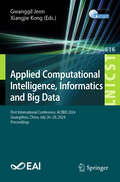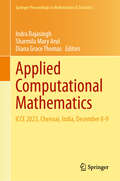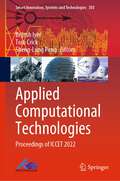- Table View
- List View
Applied Akka Patterns: A Hands-On Guide to Designing Distributed Applications
by Michael Nash Wade WaldronWhen it comes to big data processing, we can no longer ignore concurrency or try to add it in after the fact. Fortunately, the solution is not a new paradigm of development, but rather an old one. With this hands-on guide, Java and Scala developers will learn how to embrace concurrent and distributed applications with the open source Akka toolkit. You’ll learn how to put the actor model and its associated patterns to immediate and practical use.Throughout the book, you’ll deal with an analogous workforce problem: how to schedule a group of people across a variety of projects while optimizing their time and skillsets. This example will help you understand how Akka uses actors, streams, and other tools to stitch your application together.Model software that reflects the real world with domain-driven designLearn principles and practices for implementing individual actorsUnlock the real potential of Akka with patterns for combining multiple actorsUnderstand the consistency tradeoffs in a distributed systemUse several Akka methods for isolating and dealing with failuresExplore ways to build systems that support availability and scalabilityTune your Akka application for performance with JVM tools and dispatchers
Applied Algebra: Codes, Ciphers and Discrete Algorithms, Second Edition (Discrete Mathematics and Its Applications)
by Darel W. Hardy Fred Richman Carol L. WalkerUsing mathematical tools from number theory and finite fields, Applied Algebra: Codes, Ciphers, and Discrete Algorithms, Second Edition presents practical methods for solving problems in data security and data integrity. It is designed for an applied algebra course for students who have had prior classes in abstract or linear algebra. While the content has been reworked and improved, this edition continues to cover many algorithms that arise in cryptography and error-control codes. New to the Second Edition Downloadable resources containing an interactive version of the book that is powered by Scientific Notebook®, a mathematical word processor and easy-to-use computer algebra system New appendix that reviews prerequisite topics in algebra and number theory Double the number of exercises Instead of a general study on finite groups, the book considers finite groups of permutations and develops just enough of the theory of finite fields to facilitate construction of the fields used for error-control codes and the Advanced Encryption Standard. It also deals with integers and polynomials. Explaining the mathematics as needed, this text thoroughly explores how mathematical techniques can be used to solve practical problems. About the AuthorsDarel W. Hardy is Professor Emeritus in the Department of Mathematics at Colorado State University. His research interests include applied algebra and semigroups.Fred Richman is a professor in the Department of Mathematical Sciences at Florida Atlantic University. His research interests include Abelian group theory and constructive mathematics.Carol L. Walker is Associate Dean Emeritus in the Department of Mathematical Sciences at New Mexico State University. Her research interests include Abelian group theory, applications of homological algebra and category theory, and the mathematics of fuzzy sets and fuzzy logic.
Applied Algorithms: Second International Conference, ICAA 2025, Kolkata, India, January 8–10, 2025, Proceedings (Lecture Notes in Computer Science #15505)
by Rajat K. De Prosenjit Gupta Subhas C. NandyThis book LNCS constitutes the refereed proceedings of the Second International Conference on Applied Algorithms, ICAA 2025, held in Kolkata, India, during January 8–10, 2025. The 26 full papers and 4 short papers are carefully reviewed and selected from 93 submissions. This conference sought original contributions related to the design, analysis, implementation, and experimental evaluation of efficient algorithms and data structures for problems.
Applied Analysis, Computation and Mathematical Modelling in Engineering: Select Proceedings of AACMME 2021 (Lecture Notes in Electrical Engineering #897)
by Santanu Saha Ray H. Jafari T. Raja Sekhar Suchandan KayalThis book is a compendium of the proceedings of the International Conference on Applied Analysis, Computation, and Mathematical Modelling in Engineering (AACMME-2021). The book covers a variety of applications such as mechanical, acoustical, physical, electrical, bio-mathematical, and computational fluid dynamics. Since mathematical modeling necessitates a wide range of skills and methods, the book concentrates on techniques that will be of specific interest to engineers, scientists, and those who work with discrete and continuous systems models. This book guides students, researchers, and professionals through the new approaches, the powerful tools for quickly mastering the most popular mathematical and computational models used in engineering and science. These new approaches enable readers to not only systematically create effective models, but also extend these models to any macroscopic physical structure.
Applied Analytics through Case Studies Using SAS and R: Implementing Predictive Models and Machine Learning Techniques
by Deepti GuptaExamine business problems and use a practical analytical approach to solve them by implementing predictive models and machine learning techniques using SAS and the R analytical language. This book is ideal for those who are well-versed in writing code and have a basic understanding of statistics, but have limited experience in implementing predictive models and machine learning techniques for analyzing real world data. The most challenging part of solving industrial business problems is the practical and hands-on knowledge of building and deploying advanced predictive models and machine learning algorithms. Applied Analytics through Case Studies Using SAS and R is your answer to solving these business problems by sharpening your analytical skills. What You'll Learn Understand analytics and basic data concepts Use an analytical approach to solve Industrial business problems Build predictive model with machine learning techniquesCreate and apply analytical strategiesWho This Book Is ForData scientists, developers, statisticians, engineers, and research students with a great theoretical understanding of data and statistics who would like to enhance their skills by getting practical exposure in data modeling.
Applied Antifragility in Technical Systems: From Principles to Applications (SpringerBriefs in Computer Science)
by Matteo Saveriano Cristian Axenie Meisam Akbarzadeh Michail A. Makridis Alexandru StancuThe book purpose is to build a foundational knowledge base by applying antifragile system design, analysis, and development in technical systems, with a focus on traffic engineering, robotics, and control engineering. The authors are interested in formalizing principles and an apparatus that turns the basic concept of antifragility into a tool for designing and building closed-loop technical systems that behave beyond robust in the face of uncertainty. As coined in the book of Nassim Taleb, antifragility is a property of a system to gain from uncertainty, randomness, and volatility, opposite to what fragility would incur. An antifragile system’s response to external perturbations is beyond robust, such that small stressors can strengthen the future response of the system by adding a strong anticipation component. The work of the Applied Antifragility Group in traffic control and robotics, led by the authors, provides a good overview on the current research status.
Applied Architecture Patterns on the Microsoft Platform
by Mike Sexton Richard Seroter Rama Ramani Stephen W. Thomas Ewan FairweatherThe book consists of a set of business scenarios and corresponding solution critiques. Each "use case" chapter is made up of a problem description, assessment of implementation options, and the selection of the ideal solution candidate. We then construct the solution using the chosen Microsoft technology.This book is for architects, developers, and managers who need to improve their knowledge of the Microsoft application platform. This book will appeal to anyone who wants to get up to speed on selecting the most appropriate platform for a particular problem. Consultants and executive leadership will also find significant value in this book. A good understanding of the general Windows platform and development technologies would be helpful.
Applied Architecture Patterns on the Microsoft Platform Second Edition
by Dmitri Olechko Gregor Noriskin Andre DovgalPresented in a scenario-driven tutorial way, we lead you through fictitious example problems and present you with the best solutions. This book is intended for architects, developers, and managers who need to improve their knowledge of the Microsoft application platform. This book will appeal to anyone, especially consultants, who want to get up to speed on selecting the most appropriate platform for a particular problem. A good understanding of the general Windows platform and development technologies would be helpful.
Applied Artificial Intelligence 2: The Second Serbian International Conference on Applied Artificial Intelligence (SICAAI) (Lecture Notes in Networks and Systems #999)
by Nenad FilipovićThe book Applied Artificial Intelligence 2: Medicine, Biology, Chemistry, Financial, Games, Engineering is providing exceptional chapters of the state-of-the-art research knowledge and results on the innovative theories, methodology and applications of artificial intelligence and its sub-domain like deep learning, machine learning in different areas such as medicine, economy, education, law, smart city, government, industry etc. Innovative research ideas on how to solve problems using artificial intelligence, both in R&D and real-time applications are presented. Chapters describe the advanced prototypes, systems, methodologies, tools and techniques and general survey papers, which indicate future directions. These Chapters are extended papers from the Second Serbian International Conference on Applied Artificial Intelligence (SICAAI), which was held in Kragujevac, Serbia, on May 19-20, 2023
Applied Artificial Intelligence 4: The Third Serbian International Conference on Applied Artificial Intelligence (SICAAI) (Lecture Notes in Networks and Systems #1446)
by Nenad FilipovićThe book covers the state-of-the-art research knowledge and results on the innovative theories, methodology and applications of artificial intelligence and its sub-domain like deep learning in different areas such as medicine, economy, education, law, smart city, government, industry etc. Moreover, the book aims to provide a platform for researchers and practitioners for both academia and industry to share the information about cutting-edge developments in the field of artificial intelligence. The chapters in this book integrated approach toward global exchange of information on technological advances, scientific innovations and the effectiveness of various regulatory programs toward AI application in medicine, biology, chemistry, financial, games, law and engineering. Real examples from academia and industry give beyond state of the art for application of AI in different areas. These chapters are extended papers from the Third Serbian International Conference on Applied Artificial Intelligence (SICAAI), which was held in Kragujevac, Serbia, on May 23–24, 2024.
Applied Artificial Intelligence in Business: Concepts and Cases (Applied Innovation and Technology Management)
by Liliya Hogaboam Leong Chan Renzhi CaoThis book offers students an introduction to the concepts of big data and artificial intelligence (AI) and their applications in the business world. It answers questions such as what are the main concepts of artificial intelligence and big data? What applications for artificial intelligence and big data analytics are used in the business field? It offers application-oriented overviews and cases from different sectors and fields to help readers discover and gain useful insights. Each chapter features discussion questions and summaries. To assist professors in teaching, the book supplementary materials will include answers to questions, and presentation slides.
Applied Artificial Intelligence: Medicine, Biology, Chemistry, Financial, Games, Engineering (Lecture Notes in Networks and Systems #659)
by Nenad FilipovicThe book is covering knowledge and results in theory, methodology, and applications of artificial intelligence and machine learning in academia and industry. Nowadays, artificial intelligence has been used in every company where intelligence elements are embedded inside sensors, devices, machines, computers and networks. The chapters in this book integrated approach toward global exchange of information on technological advances, scientific innovations, and the effectiveness of various regulatory programs toward AI application in medicine, biology, chemistry, financial, games, law, and engineering. Readers can find AI application in industrial workplace safety, manufacturing systems, medical imaging, biomedical engineering application, different computational paradigm, COVID-19, liver tracking, drug delivery system, and cost-effectiveness analysis. Real examples from academia and industry give beyond state of the art for application of AI and ML in different areas. These chapters are extended papers from the First Serbian International Conference on Applied Artificial Intelligence (SICAAI), which was held in Kragujevac, Serbia, on May 19–20, 2022.
Applied Artificial Intelligence: Where AI Can Be Used In Business (Springerbriefs In Complexity Ser.)
by Francesco CoreaThis book deals with artificial intelligence (AI) and its several applications. It is not an organic text that should be read from the first page onwards, but rather a collection of articles that can be read at will (or at need). The idea of this work is indeed to provide some food for thoughts on how AI is impacting few verticals (insurance and financial services), affecting horizontal and technical applications (speech recognition and blockchain), and changing organizational structures (introducing new figures or dealing with ethical issues). <P><P> The structure of the chapter is very similar, so I hope the reader won’t find difficulties in establishing comparisons or understanding the differences between specific problems AI is being used for. The first chapter of the book is indeed showing the potential and the achievements of new AI techniques in the speech recognition domain, touching upon the topics of bots and conversational interfaces. The second and thirds chapter tackle instead verticals that are historically data-intensive but not data-driven, i.e., the financial sector and the insurance one. The following part of the book is the more technical one (and probably the most innovative), because looks at AI and its intersection with another exponential technology, namely the blockchain. Finally, the last chapters are instead more operative, because they concern new figures to be hired regardless of the organization or the sector, and ethical and moral issues related to the creation and implementation of new type of algorithms.
Applied Aspects of Optical Communication and LIDAR
by Nathan Blaunstein Shlomi Arnon Natan Kopeika Arkadi ZilbermanExploring the practical aspects of atmospheric optical communication and light detection and ranging (LIDAR), Applied Aspects of Optical Communication and LIDAR details the role of atmospheric structures in propagation phenomena that influence the transmission of optical signals through perturbed atmospheric communication channels. It examines nume
Applied Assistive Technologies and Informatics for Students with Disabilities (Applied Intelligence and Informatics)
by Mufti Mahmud Rajesh Kaluri Thippa Reddy Gadekallu Dharmendra Singh Rajput Kuruva LakshmannaThe book “Applied Assistive Technologies and Informatics for Students with Disabilities” provides a comprehensive guide to assist students with learning disabilities in higher education via modern assistive technologies and informatics. This book will take us on a tour of the various modern assistive technologies, such as artificial intelligence (AI), blockchain, computer vision (CV), text analytics (TA), the metaverse, human-computer interaction (HCI), digital twins (DT), and federated learning (FL), and how they support higher education students with learning disabilities. This book is intended for students with learning disabilities, scientists and researchers, lecturers and teachers, academic and corporate libraries, practitioners, and professionals who are interested in providing inclusive education to students with learning disabilities through the application of modern assistive technologies and informatics. This book is ideal for readers who are new to the subject and knowledgeable about the principles of inclusive education. In addition, it is a fantastic resource for teachers and parents assisting students with learning disabilities. This book can be a powerful tool to educate more students about learning disabilities, which can help eradicate the bullying of these students.
Applied Bioinformatics (2nd Edition): An Introduction
by Paul M. Selzer Oliver Koch Richard J. MarhöferThis book introduces readers to the basic principles of bioinformatics and the practical application and utilization of computational tools, without assuming any prior background in programming or informatics. <P><P>It provides a coherent overview of the complex field and focuses on the implementation of online tools, genome databases and software that can benefit scientists and students in the life sciences. Training tutorials with practical bioinformatics exercises and solutions facilitate the understanding and application of such tools and interpretation of results. In addition, a glossary explains terminology that is widely used in the field. This straightforward introduction to applied bioinformatics offers an essential resource for students, as well as scientists seeking to understand the basis of sequencing analysis, functional genomics and protein structure predictions.
Applied Cloud Deep Semantic Recognition: Advanced Anomaly Detection
by Mehdi Roopaei and Paul RadThis book provides a comprehensive overview of the research on anomaly detection with respect to context and situational awareness that aim to get a better understanding of how context information influences anomaly detection. In each chapter, it identifies advanced anomaly detection and key assumptions, which are used by the model to differentiate between normal and anomalous behavior. When applying a given model to a particular application, the assumptions can be used as guidelines to assess the effectiveness of the model in that domain. Each chapter provides an advanced deep content understanding and anomaly detection algorithm, and then shows how the proposed approach is deviating of the basic techniques. Further, for each chapter, it describes the advantages and disadvantages of the algorithm. The final chapters provide a discussion on the computational complexity of the models and graph computational frameworks such as Google Tensorflow and H2O because it is an important issue in real application domains. This book provides a better understanding of the different directions in which research has been done on deep semantic analysis and situational assessment using deep learning for anomalous detection, and how methods developed in one area can be applied in applications in other domains. This book seeks to provide both cyber analytics practitioners and researchers an up-to-date and advanced knowledge in cloud based frameworks for deep semantic analysis and advanced anomaly detection using cognitive and artificial intelligence (AI) models.
Applied Cognitive Computing and Artificial Intelligence: 8th International Conference, ACC 2024, and 26th International Conference, ICAI 2024, Held as Part of the World Congress in Computer Science, Computer Engineering and Applied Computing, CSCE 2024, Las Vegas, NV, USA, July 22–25, 2024, Revised Selected Papers (Communications in Computer and Information Science #2251)
by Hamid R. Arabnia Leonidas Deligiannidis Ken FerensThis book constitutes the proceedings of the 8th International Conference on Applied Cognitive Computing, ACC 2024, and the 26th International Conference on Artificial Intelligence, ICAI 2024, held as part of the 2024 World Congress in Computer Science, Computer Engineering and Applied Computing, in Las Vegas, USA, during July 22 to July 25, 2024. This proceedings book includes 9 papers from ACC 2024 and 31 papers from ICAI 2024. They have been organized in topical sections as follows: Applied cognitive computing and artificial intelligence; artificial intelligence and applications; artificial intelligence: reinforcement learning and knowledge engineering; and artificial intelligence: optimization methods and machine learning.
Applied Compositional Data Analysis: With Worked Examples In R (Springer Series in Statistics)
by Peter Filzmoser Matthias Templ Karel HronThis book presents the statistical analysis of compositional data using the log-ratio approach. It includes a wide range of classical and robust statistical methods adapted for compositional data analysis, such as supervised and unsupervised methods like PCA, correlation analysis, classification and regression. In addition, it considers special data structures like high-dimensional compositions and compositional tables. The methodology introduced is also frequently compared to methods which ignore the specific nature of compositional data. It focuses on practical aspects of compositional data analysis rather than on detailed theoretical derivations, thus issues like graphical visualization and preprocessing (treatment of missing values, zeros, outliers and similar artifacts) form an important part of the book. Since it is primarily intended for researchers and students from applied fields like geochemistry, chemometrics, biology and natural sciences, economics, and social sciences, all the proposed methods are accompanied by worked-out examples in R using the package robCompositions.
Applied Computation and Security Systems: Volume One (Advances in Intelligent Systems and Computing #304)
by Khalid Saeed Nabendu Chaki Rituparna Chaki Sankhayan ChoudhuryThis book contains the extended version of the works that have been presented and discussed in the First International Doctoral Symposium on Applied Computation and Security Systems (ACSS 2014) held during April 18-20, 2014 in Kolkata, India. The symposium has been jointly organized by the AGH University of Science & Technology, Cracow, Poland and University of Calcutta, India. The Volume I of this double-volume book contains fourteen high quality book chapters in three different parts. Part 1 is on Pattern Recognition and it presents four chapters. Part 2 is on Imaging and Healthcare Applications contains four more book chapters. The Part 3 of this volume is on Wireless Sensor Networking and it includes as many as six chapters. Volume II of the book has three Parts presenting a total of eleven chapters in it. Part 4 consists of five excellent chapters on Software Engineering ranging from cloud service design to transactional memory. Part 5 in Volume II is on Cryptography with two book chapters in it. Part 6 of this volume is on Computer Aided Design with four chapters in it. We strongly believe that the twenty five chapters in these two volumes of Applied Computation and Security Systems will be appreciated by all its readers.
Applied Computational Fluid Dynamics and Turbulence Modeling: Practical Tools, Tips and Techniques
by Sal RodriguezThis unique text provides engineering students and practicing professionals with a comprehensive set of practical, hands-on guidelines and dozens of step-by-step examples for performing state-of-the-art, reliable computational fluid dynamics (CFD) and turbulence modeling. Key CFD and turbulence programs are included as well. The text first reviews basic CFD theory, and then details advanced applied theories for estimating turbulence, including new algorithms created by the author. The book gives practical advice on selecting appropriate turbulence models and presents best CFD practices for modeling and generating reliable simulations. The author gathered and developed the book’s hundreds of tips, tricks, and examples over three decades of research and development at three national laboratories and at the University of New Mexico—many in print for the first time in this book. The book also places a strong emphasis on recent CFD and turbulence advancements found in the literature over the past five to 10 years. Readers can apply the author’s advice and insights whether using commercial or national laboratory software such as ANSYS Fluent, STAR-CCM, COMSOL, Flownex, SimScale, OpenFOAM, Fuego, KIVA, BIGHORN, or their own computational tools. Applied Computational Fluid Dynamics and Turbulence Modeling is a practical, complementary companion for academic CFD textbooks and senior project courses in mechanical, civil, chemical, and nuclear engineering; senior undergraduate and graduate CFD and turbulence modeling courses; and for professionals developing commercial and research applications.
Applied Computational Intelligence and Mathematical Methods: Computational Methods in Systems and Software 2017, vol. 2 (Advances in Intelligent Systems and Computing #662)
by Radek Silhavy Petr Silhavy Zdenka ProkopovaThe book discusses real-world problems and exploratory research in computational intelligence and mathematical models. It brings new approaches and methods to real-world problems and exploratory research that describes novel approaches in the mathematical methods, computational intelligence methods and software engineering in the scope of the intelligent systems. This book constitutes the refereed proceedings of the Computational Methods in Systems and Software 2017, a conference that provided an international forum for the discussion of the latest high-quality research results in all areas related to computational methods, statistics, cybernetics and software engineering.
Applied Computational Intelligence, Informatics and Big Data: First International Conference, ACIIBD 2024, Guangzhou, China, July 26–28, 2024, Proceedings (Lecture Notes of the Institute for Computer Sciences, Social Informatics and Telecommunications Engineering #616)
by Gwanggil Jeon Xiangjie KongThis book LNICST 616 constitutes the proceedings of the First International Conference on Applied Computational Intelligence, Informatics and Big Data, ACIIBD 2024, held in Guangzhou, China, during July 26–28, 2024. The 3 full papers and 15 shot papers were carefully reviewed and selected from 56 submissions. This Proceedings cover topics on Internet of Things, Information Communication Technology, Edge Computing, Mobile Computing, Neural Network, Intelligent Control System, Real-Time Information System, Intelligent Perception and many other cutting-edge fields and disciplines.
Applied Computational Mathematics: ICCE 2023, Chennai, India, December 8-9 (Springer Proceedings in Mathematics & Statistics #480)
by Indra Rajasingh Sharmila Mary Arul Diana Grace ThomasThis proceedings volume showcases high-quality original research papers presented at the International Conference on Computational Engineering (ICCE 2023), held in Chennai, India, from December 8-9, 2023 dedicated to advancing interdisciplinary research in the realm of mathematics and its pivotal role in Computer Engineering. Explore the dynamic field of Computational Engineering, where innovative computational techniques—such as computer simulations, mathematical modeling, and numerical analysis—are employed to tackle complex engineering challenges. By integrating principles from engineering, computer science, and applied mathematics, this collection illustrates how virtual prototypes enable engineers to analyze and optimize systems before physical testing, saving valuable time and resources. Featuring selected works from conference participants and outstanding contributions from external researchers, this book highlights the broad applications of Computational Engineering across civil, mechanical, aerospace, chemical, electrical engineering, and beyond. Dive into cutting-edge research that paves the way for future advancements in engineering practices.
Applied Computational Technologies: Proceedings of ICCET 2022 (Smart Innovation, Systems and Technologies #303)
by Sheng-Lung Peng Brijesh Iyer Tom CrickThis book is a collection of best selected research papers presented at 7th International Conference on Computing in Engineering and Technology (ICCET 2022), organized by Dr. Babasaheb Ambedkar Technological University, Lonere, India, during February 12 – 13, 2022. Focusing on frontier topics and next-generation technologies, it presents original and innovative research from academics, scientists, students, and engineers alike. The theme of the conference is Applied Information Processing System.
